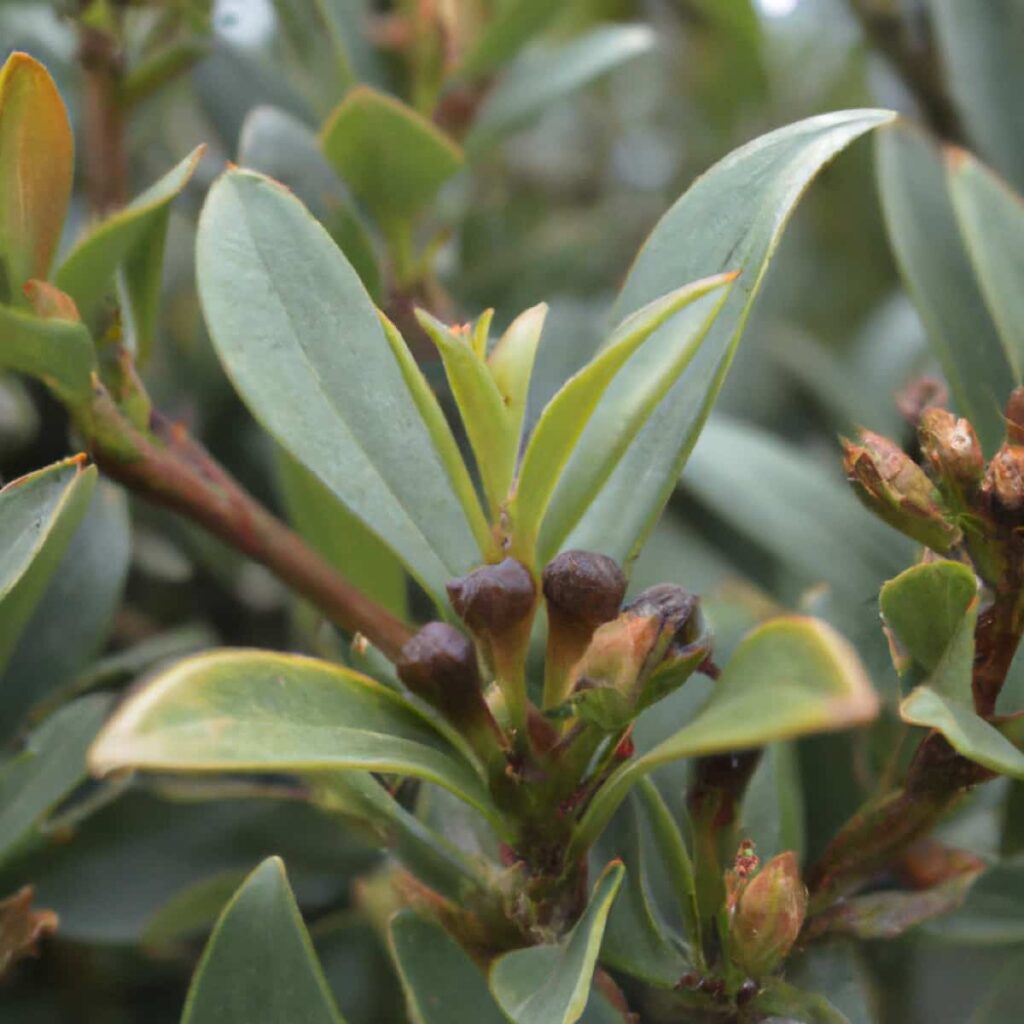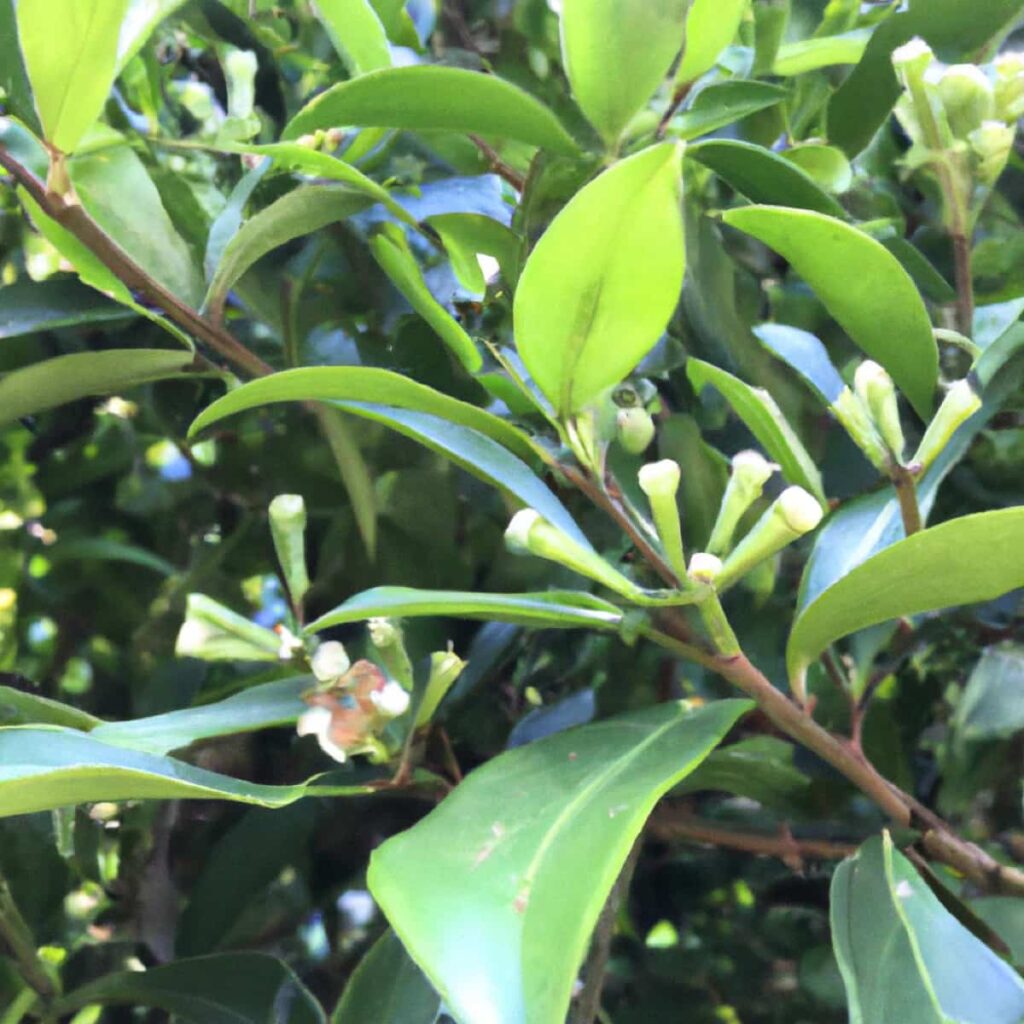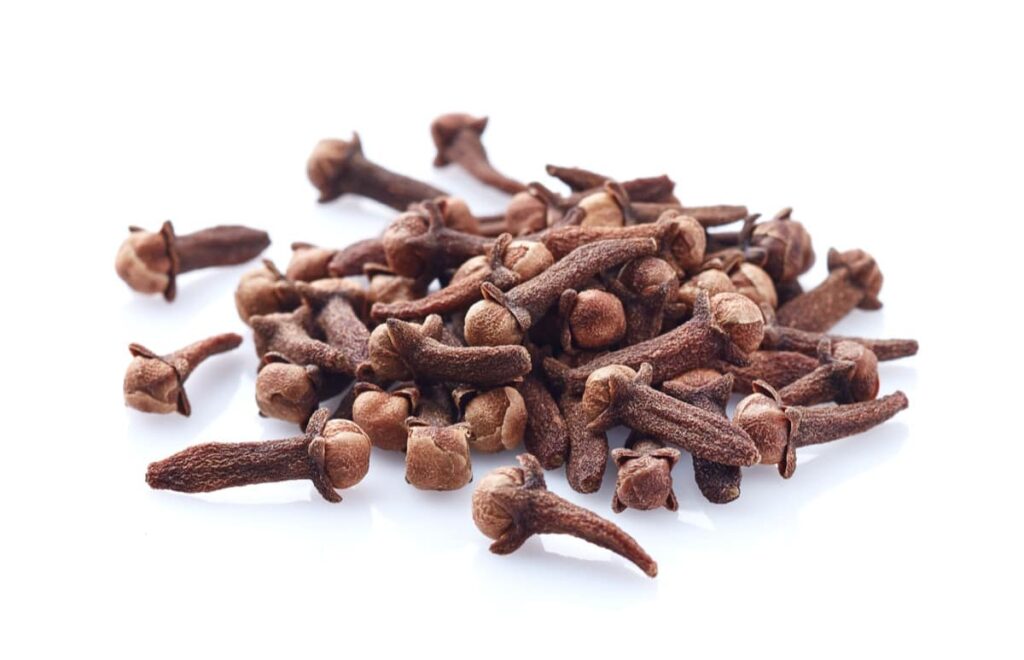Starting a successful clove farming business requires a comprehensive business plan that includes market research, production costs, and distribution channels. It’s important to consider factors such as soil quality, climate, and irrigation when selecting a location for the farm. To produce high-quality cloves, careful selection of clove varieties, proper planting techniques, and regular crop maintenance is essential.

Introduction to Clove Plant
- Clove plants are known for their aromatic flower buds, commonly used as a spice, flavoring, or fragrance.
- Clove plants are native to the Maluku Islands in Indonesia.
- The clove tree evergreen tree that can grow up to 8-12 meters tall, with large leaves and crimson flowers in terminal clusters.
- The flower buds of the clove plant start with a pale hue, turn green, and then become bright red when they are ready to be harvested.
- Cloves are harvested when they are between 1.5 and 2 centimeters long and have a long calyx with four extending sepals and four unopened petals forming a small central disk.
- Clove stalks are short stems of the inflorescence axis with opposite decussate branching. Mother cloves are the mature fruits of the cloves; they are oval, brown, unilocular berries with a single seed.
- Dried cloves have had most or all of their oil taken by distillation, resulting in no oil and a darkened color.
Benefits of Clove Farming
- Culinary uses: Cloves are used in different dishes and cuisines worldwide, lending flavor and aroma to meats, fruits, and spices. They are also a common ingredient in spice blends.
- Non-culinary uses: Cloves produce kretek cigarettes in Indonesia and inhibit mold growth on various foods. Clove essential oil has also effectively protected wood and can be used in cultural heritage conservation.
- Medicinal uses: Clove oil has been traditionally used as an analgesic, especially for toothaches. It may also prevent bacterial growth and treat certain medical conditions.
- Potential for profit: Clove farming can be profitable due to the high demand for cloves and their various uses.
- Sustainability: Clove trees are evergreen and can provide a sustainable income source for farmers while promoting environmental sustainability.
In case you missed it: How to Make Silage for Livestock: Business Plan, Preparation Process for Goats, Sheep, Pigs, and Cows

How to Grow Clove and Production
Clove trees are grown in tropical regions and require a specific climate and soil conditions. The cultivation process includes land preparation, planting, manure and fertilizer application, and crop rotation. Clove production involves harvesting and drying flower buds for culinary and medicinal purposes.
Clove Varieties for Farming
The Zanzibar variety of clove trees is the most commonly grown type for commercial production. It is known for its high yield of high-quality cloves and its ability to grow in various soil and climate conditions. This variety is native to the Zanzibar archipelago, which includes Tanzania and Pemba Island, and has been cultivated there for centuries. It is also grown in other countries, including Indonesia, Madagascar, and India.
Climate and Soil Required for Clove Farming
- Clove trees require a warm and humid tropical climate to grow, ranging from 20-30°C (68-86°F).
- They require well-drained soil that is rich in organic matter.
- The ideal pH range for clove cultivation is between 5.5 and 6.5.
- The soil should be free from rocks and other debris, as they impede root development.
- Clove trees also require ample rainfall, with an annual average of at least 1500mm (60 inches).
- They are sensitive to waterlogging, so the soil should have good drainage.
- Clove trees are usually grown at elevations ranging from 100 to 1000 meters above sea level.
Process of Clove Plantation from Seed
- Clove trees can be propagated by cuttings or seeds, with seed propagation preferred. Seeds should be planted immediately after harvesting and should not be covered with soil since they require light to germinate.
- If using a container, cover it with plastic to increase humidity levels. Fresh seeds should be used since dry seeds are less likely to germinate.
- Clove trees can also be grown in containers, but the container should have a proper drainage system and be at least 18 inches in diameter. The container should be kept in a bright spot with access to indirect sunlight and a consistent temperature of 65 to 80 degrees Fahrenheit.
- Clove trees should be planted in rows. Each spaced pit of 75 cm x 75 cm x 75 cm size is dug at a spacing of 6-7 m. This allows enough space for the trees to grow and adequate sunlight to reach each tree.
In case you missed it: The Ultimate Guide to Creating a Profitable Turmeric Farming Business Plan

Manure and Fertilizer in Clove Farming
- Clove trees require regular application of manure and fertilizer for optimal growth and yield.
- Cattle manure or compost may be applied at a rate of 40-50 kilograms per flowering tree annually.
- Two to five kilograms of bone or fish meal can be applied annually per bearing tree.
- Organic manures can be applied as a single dose in trenches excavated around trees at the start of the rainy season. Inorganic fertilizers can also be applied, with initial rates of 20 g N, 18 g P2O5, and 50 g K2O per tree.
- The dosage is gradually increased to 300 g N, 250 g P2O5, and 750 g K2O per year for a 15-year-old or older mature tree.
- Fertilizers should be given in two equal split doses during the months of May-June and September-October in 1-1.5 m-deep trenches dug around the plant’s base.
Clove Pests and Diseases Management
Seedling Wilt
Seedling wilt, induced by Cylindrocladium sp., Fusarium sp., and Rhizoctonia sp., is a serious problem in nurseries. Infected plants must be removed, and the remaining seedlings must be sprayed and drenched with 0.1% carbendazim solution. Alternately, the foliage could be sprayed with 1% Bordeaux mixture and the soil could be saturated with 0.2% copper oxychloride.
Leaf Rot
Cylindrocladium quinqueseptatum causes leaf rot, resulting in severe defoliation. The foliage of afflicted trees should be sprayed with a 0.1% solution of carbendazim. Additionally, Bordeaux mixture 1% prophylactic applications prevent the disease.
Leaf Spot and Bud Shedding
The fungus Colletotrichum gloeosporioides causes leaf spots that are dark brown with a yellow halo. Both maladies can be prevented by applying a 1% Bordeaux mixture as a preventative spray.
Stem Borer
The stem borer (Sahyadrassus malabaricus) infests the main stem at the base of young plants. The infestation causes the trees to wilt and ultimately perish. After removing the frass, spray quinalphos 0.1% around the borehole and inject it into the borehole. Carbaryl swabs applied to the base of the main stem and weed-free basins are preventative measures for reducing insect infestation.
Scale Insects
Numerous scale insects infest clove seedlings and immature plants in the nursery and in the field. Feeding on plant sap, scale insects cause yellow spots on leaves and withering.
In case you missed it: Harvest Fresh and Healthy: Best Top 10 Vegetables for Terrace Garden/Rooftop Farming

Clove Harvesting and Post-Harvest Operations
- Clove trees start flowering in the fourth year, but full bearing is achieved by the 15th year.
- The flowering season varies from September-October in the plains to December-January at high altitudes.
- Unopened flower buds less than 2 cm long are harvested before they turn pink.
- Opened flowers are not valued as a spice.
- Harvesting must be done without damaging the branches to avoid affecting subsequent tree growth.
- Mother of clove is not allowed to bear fruit, as it is believed to have an adverse effect on subsequent flowering.
- Harvested buds are separated by hand and dried in a yard.
- The correct drying stage is reached when the stem is dark brown, and the rest of the bud is light brown.
- Well-dried cloves weigh about one-third the weight of fresh cloves.
- Approximately 11,000 to 15,000 dried cloves weigh 1 kg.
Project Report on Clove Cultivation
Clove cultivation is profitable in India due to the high demand for clove domestically and internationally. Clove is a spice with a distinct aroma and flavor, and it is used in many dishes worldwide. This project report provides an overview of clove cultivation, including costs, clove prices, and income.
Costs of Clove Cultivation
The initial investment for clove cultivation includes land preparation, planting material, fertilizers, and labor. Land preparation costs approximately INR 15,000 per acre ($200), while planting material costs around INR 5,000 ($67). Fertilizers cost around INR 12,000 ($160) per acre, and labor costs approximately INR 20,000 ($267). The total cost of cultivation per acre is approximately INR 52,000- 70,000 ($693-$850).
In case you missed it: Top 10 Vegetables to Grow With the Help of a Pergola

Clove Prices
Clove prices vary depending on the quality of the spice and the market demand. On average, the price of clove is around INR 700 ($9.33) per kg in the Indian market. However, the international market price is around USD 10 per kg, higher than the Indian market price.
Income
The income from clove cultivation depends on the yield and the market price. On average, cloves yield is around 200-250 kg per acre. At the current market price, the income from one acre of clove cultivation is around INR 1,75,000 ($2,333) in the Indian market and USD 2,500 in the international market. The net profit from one acre of clove cultivation ranges around INR 1,23,000- 1,70,000 ($1,640-$2069) in the Indian market and USD 1,800 in the international market.
Clove Farming Business Plan
- Market research: Research the demand and supply of cloves in your target market, including price trends and consumer preferences.
- Target customers: Identify potential buyers for your cloves, such as spice companies, food manufacturers, and wholesalers.
- Production costs: Calculate the costs associated with setting up and maintaining a clove farm, including land, labor, equipment, and inputs such as fertilizers and pesticides.
- Distribution channels: Determine the most efficient and cost-effective ways to transport your cloves from the farm to the market.
- Crop maintenance: Develop a plan for maintaining your clove trees, including irrigation, pest and disease management, and pruning.
- Financial projections: Use your research and cost calculations to create realistic projections for revenue, expenses, and profits over time.
- Risk assessment: Identify potential risks and challenges that may impact your business, such as weather events or market fluctuations, and develop strategies to mitigate them.
In case you missed it: From Idea to Reality: A Comprehensive Project Report on Agro Shade Net Manufacturing in India

Business Plan Components
- Executive summary: A brief overview of the entire business plan, including key objectives and financial projections.
- Company description: A detailed description of the company, including its mission statement, ownership structure, and legal status.
- Market analysis: A comprehensive analysis of the clove industry, including market trends, target customers, and competition.
- Product or service line: A detailed description of the products or services the clove farming business offers, including the variety of cloves grown and any value-added products or services.
- Marketing and sales: A detailed plan marketing and sales, including pricing strategies, distribution channels, and promotional activities.
- Operations and management: A description of the daily operations of the clove farming business, including the farming process, management structure, and staffing requirements.
- Financial projections: Detailed financial projections for the clove farming business, including revenue, expenses, and profit margins.
- Funding requirements: A detailed description of the funding requirements for the clove farming business, including the amount of capital required and potential funding sources.
- Appendix: Any additional information that may be relevant to the business plan, including market research data, legal documents, and resumes of key personnel.
Market Research and Analysis
- The World Bank report provides a comprehensive analysis of the clove farming industry in Indonesia, highlighting the country’s dominance in the global market and the challenges smallholder farmers face.
- As per the report, Indonesia accounts for approximately 80% of the world’s clove production, with the majority concentrated in a few regions. The demand for clove is growing globally, driven by its use in the food, cosmetic, and pharmaceutical industries.
- However, smallholder farmers in Indonesia face various challenges, such as limited access to credit, poor infrastructure, and low productivity. These challenges have resulted in a decline in the competitiveness of the Indonesian clove industry in recent years.
- Comprehensive market research and analysis in the clove farming business plan must include a study of the global and domestic market demand for clove, the supply chain, key players, competitors in the market, consumer preferences, and the regulatory environment.
Conclusion
Starting a clove farming business requires careful planning and execution. A comprehensive business plan that includes market research, production costs, and distribution channels is crucial. Focusing on growing high-quality cloves and proper post-harvest operations is also important to ensure success in the clove farming industry.
- How to Raise Pigs in Your Own Backyard: A Comprehensive Guide
- Budget Friendly Sheep Shed Ideas: Cheap and Low-Cost Tips
- How Much Do Cattle Farmers Make: Revenue Streams in Cattle Farming
- Management Pests and Diseases in Your Cotton Field
- Sheep Farming Business Plan for Beginners
- Aquaponic Farming at Home: A Step-By-Step Guide
- Profitable Village Farming Business Ideas in 2024
- High-Yield Aquaculture: Fast-Growing Fish for Farming
- Effective Fish Pond Construction Techniques for Beginners
- Irrigation and Water Management in Pineapple Farming
- Blossom to Harvest: Mastering Flowering and Pollination in Papaya Farming
- Pig Fattening Essentials: From Selection to Sale for Beginners
- Raising Wagyu Cattle: A Complete Guide for Premium Beef Production
- Soil Types and Their Water Holding Capacity
- Optimizing Irrigation Schedules for Coconut Groves for Enhanced Yield
- Espresso Your Garden: Coffee Grounds for Healthier Acid-Loving Plants
- The Best Soil Mix for Snake Plants: How to Mix Your Own Snake Plant Soil
- Green Thumb Success: Expert Tips for Cultivating Greenhouse Beans All Year Round
- Bloom All Year Round: The Ultimate Guide to Indoor Hyacinth Care
- Eco-Friendly Gardening: How to Make Liquid Fertilizer from Kitchen Waste
- Ultimate Guide to Grow Anise in Pots: Explore Seed Propagation to Harvesting
- Guide to Raising Chester White Pigs: Discover Breed Facts to Growth Management
- Mastering the Elegance: The Ultimate Guide to Weeping Cherry Tree Care, Planting, and Maintenance
- Ultimate Guide to Planting Garlic in Grow Bags: Growing Strategies for Beginners
- How to Fix Spider Plant Leaf-Related Problems: Natural and Organic Remedies
- 10 Reasons Why Your Tulsi Plant is Shedding Leaves: Home Remedies and Solutions
- Optimizing Growth and Yield: The Advantages of Palm Bunch Ash Fertilizer
- Utilizing Neem Oil Extract as a Natural Pesticide for Hydrangea
- From Soil to Harvest: Various Ways in Which Farmers Can Use AI Tools
- Steps to Encourage and Induce Citrus Flowers: A Comprehensive Guide
- How to Fix Snake Plant Leaf-Related Issues: Natural and Organic Remedies
- Transform Your Garden into a Fragrant Oasis with Raat Ki Rani (Night Blooming Jasmine)
- Discover the Ideal Chicken Breeds for Philippine Farms
- How to Create a Poultry Egg Farm Business Plan for Profits
- Grow Lemon Cucumbers Like a Pro: Insider Techniques for Bountiful Yields
- Ultimate Guide to Caring for Your Pink Princess Philodendron: Tips for Thriving Variegation
